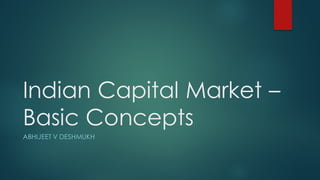The document provides an overview of the Indian capital market, highlighting the importance of investing to counter inflation, the history and evolution of stock exchanges in India, and key market concepts such as primary and secondary markets, financial instruments, and regulations by the Securities and Exchange Board of India (SEBI). It explains the types of stocks, trading mechanisms, and the roles of various market participants, emphasizing the significance of understanding market dynamics for effective investing. Additionally, it discusses strategies like cost averaging and the necessity of price targets and stop-loss measures.






























































